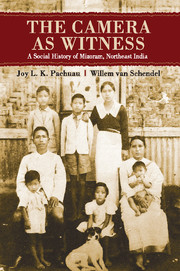Book contents
- Frontmatter
- Contents
- List of Figures
- List of Maps
- Acknowledgements
- I Becoming Mizo
- II Mizoram in the New India
- III Visions of Independence
- 17 Famine and Revolt
- 18 The Mizoram Government at Home and in East Pakistan
- 19 The Mizoram Government in Burma, China and Bangladesh
- 20 A State and its Minorities
- IV Mizo Modernities
- Copyrights and Sources
- Glossary
- Bibliography
- Index
20 - A State and its Minorities
from III - Visions of Independence
Published online by Cambridge University Press: 05 May 2015
- Frontmatter
- Contents
- List of Figures
- List of Maps
- Acknowledgements
- I Becoming Mizo
- II Mizoram in the New India
- III Visions of Independence
- 17 Famine and Revolt
- 18 The Mizoram Government at Home and in East Pakistan
- 19 The Mizoram Government in Burma, China and Bangladesh
- 20 A State and its Minorities
- IV Mizo Modernities
- Copyrights and Sources
- Glossary
- Bibliography
- Index
Summary
During the disturbed years between 1966 and 1986, Mizoram witnessed guerrilla warfare, military repression, human rights abuses, population displacement, fear and mistrust. Most of the victims were civilians who bore the brunt of counterinsurgency strategies that were both military and demographic, as described in Chapter 17. But counterinsurgency also included administrative planning, and this met with approval because it severed links with Assam. In 1972, Mizoram was detached from this larger state and made a Union Territory – under direct administration from Delhi. At the same time, three ‘autonomous districts’ were created in the south: the Mara, Lai and Chakma Autonomous Districts.
Union territory
Awarding Mizoram the status of a Union Territory was a decision that the authorities in Delhi took with the intention to outflank the Mizoram Government-in-exile and to reward Mizo politicians who had been cooperating with them. Many Mizos welcomed the new status but only as a step in the right direction: independent statehood remained the ultimate goal. Figure 20.1 shows the Indian Prime Minister arriving at the Assam Rifles Ground in Aizawl for the inauguration; and Figure 20.2 shows the crowd awaiting her.
With the status of Union Territory came the trappings of home rule, Indian style. Delhi sent its first Governor to Aizawl to oversee a Mizo Chief Minister and his cabinet (Figure 20.3).
Creating minorities
Severing Mizoram from Assam empowered the majority population of Mizoram and emphasized the minority status of those who did not consider themselves Mizos. In Chapter 1, we explained that ethnic labels have been remarkably unstable and that it is problematic to use the same ones for the entire period that this book covers. Self-representations have changed and for hill dwellers today the designations ‘Zo family’ (Zo-fate) and ‘branches of the Zo tree’ (Zo hnahthlak) indicate a broad ethnic category of groups that they identify with. The hill people also use more local monikers to distinguish subgroups at different levels.
- Type
- Chapter
- Information
- The Camera as WitnessA Social History of Mizoram, Northeast India, pp. 359 - 376Publisher: Cambridge University PressPrint publication year: 2015

